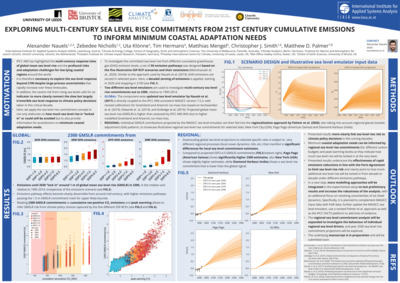Nauels, A.  ORCID: https://orcid.org/0000-0003-1378-3377, Nicholls, Z.
ORCID: https://orcid.org/0000-0003-1378-3377, Nicholls, Z.  ORCID: https://orcid.org/0000-0002-4767-2723, Klönne, U., Hermans, T., Mengel, M., Smith, C.
ORCID: https://orcid.org/0000-0002-4767-2723, Klönne, U., Hermans, T., Mengel, M., Smith, C.  ORCID: https://orcid.org/0000-0003-0599-4633, & Palmer, M.
(2024).
Exploring multi-century sea level rise commitments from 21st century cumulative emissions to inform minimum coastal adaptation needs.
DOI:10.5194/egusphere-egu24-10716.
In: EGU General Assembly 2024, 14-19 April 2024, Vienna.
ORCID: https://orcid.org/0000-0003-0599-4633, & Palmer, M.
(2024).
Exploring multi-century sea level rise commitments from 21st century cumulative emissions to inform minimum coastal adaptation needs.
DOI:10.5194/egusphere-egu24-10716.
In: EGU General Assembly 2024, 14-19 April 2024, Vienna.
![EGU24_Nauels_SLRcommit_rev.png [thumbnail of EGU24_Nauels_SLRcommit_rev.png]](https://pure.iiasa.ac.at/19622/1.hassmallThumbnailVersion/EGU24_Nauels_SLRcommit_rev.png)  Preview |
Image
EGU24_Nauels_SLRcommit_rev.png - Published Version Available under License Creative Commons Attribution Non-commercial. Download (4MB) | Preview |
Abstract
It is crucial to explore multi-century sea level responses under different emissions scenarios despite underlying physical uncertainties that rapidly increase over time, because resulting coastal risks fully manifest only on these longer timescales. Here, we use a set of climate and sea level emulators to investigate sea level rise commitments out to 2300 for cumulative emission levels at the start of every remaining 21st century decade under the five illustrative SSP-RCP scenarios. Our results indicate that emissions until 2030 “lock in” around 1.0 m (66% model range: 0.8 to 1.3 m) of global mean sea level rise in 2300 relative to 1995-2014. Under an intermediate emissions scenario roughly in line with current climate policies (SSP2-4.5), median 2300 global mean sea level commitments for cumulative emissions in 2050 (1.2 m) and 2100 (1.7 m) would be around 0.1 m and 0.6 m higher than under a very low emissions scenario (SSP1-1.9). Global results are also downscaled to selected regional sites and highlight that particularly vulnerable regions like low-lying Pacific Islands will experience higher local committed sea level rise than the global average. By attributing projected sea level rise commitments in 2300 to different cumulative emission levels in the 21st century, the study aims to more clearly link mitigation efforts in the near term to longer term coastal risk and to inform minimum adaptation requirements under different climate futures.
| Item Type: | Conference or Workshop Item (Poster) |
|---|---|
| Research Programs: | Energy, Climate, and Environment (ECE) Energy, Climate, and Environment (ECE) > Integrated Assessment and Climate Change (IACC) Energy, Climate, and Environment (ECE) > Integrated Climate Impacts (ICI) |
| Depositing User: | Luke Kirwan |
| Date Deposited: | 16 Apr 2024 07:30 |
| Last Modified: | 12 Mar 2025 05:01 |
| URI: | https://pure.iiasa.ac.at/19622 |
Actions (login required)
 |
View Item |
 Tools
Tools Tools
Tools